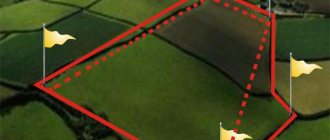Indentation standards
When purchasing a plot of land, it is recommended to carefully study the documents that indicate the exact area of the purchased property.
In some cases, the papers reflect immediate boundaries. This step will avoid subsequent conflicts during the construction of buildings.
If you are not sure that the boundaries of the site are indicated correctly, it is recommended to contact a special service to take measurements . After this, you will receive an accurate plan of the land and can begin construction. The legislation of the Russian Federation establishes special standards indicating how to build:
- It is allowed to build sheds, bathhouses, garages, and plant low-growing trees and shrubs within three meters from the boundaries of the neighboring plot. In some cases, the construction of residential buildings is allowed if the distance from the fence of the neighboring plot to the nearest wall of the building is at least three meters.
- It is allowed to erect buildings intended for keeping animals four meters from the boundaries of the neighboring plot. The same distance should be maintained from perennial trees.
- Five or more meters from window openings, as well as administrative buildings and residential buildings in cases where there is a roadway or road for pedestrians nearby.
If a shrub or tree grows too close to your boundaries, you have the right to request that the plant be removed or moved.
Such measures are necessary for safety and comfort. But what if a neighbor breaks the rules? Is it possible to build a house or other structure closely?
When building a house, how much to retreat from the fence?
Distance from the fence to the building: SNiP, standards and practical implementation
- Construction norms and rules (SNiP) 30-02-97, which regulate the procedure for planning and effective development of gardening associations and other private properties.
- Construction standard SP 11-106-97, which describes the procedure for creating design documentation for the development of private property, and also regulates its approval and coordination with licensing authorities.
How much to retreat from the fence during construction: garage, bathhouse, barn or individual housing construction house
- These are SNiP (building codes and regulations) - they regulate the procedure for planning and productive development of horticultural associations and other private estates. Compliance of the construction process with the standards described in SNiP is mandatory, since otherwise you may not suffer the most positive consequences. For example, a lawsuit from neighbors or the administration of a locality. For the defendant, such claims rarely have a positive outcome.
How much should you retreat from the fence when building a house and other buildings?
The layout of the garden requires special attention. It needs to be thought out so as not to obscure the neighbors’ territory, and at the same time have maximum benefit from the garden and vegetable garden for your needs. Tall trees with a wide crown are placed at a distance of at least 3 meters from the border of the site, and at least five meters from a residential building.
How much to retreat from the fence when building a house and other buildings on the site
In contrast, fences between neighboring properties can be highly regulated. And here it is necessary, first of all, to read the rules of the gardening partnership on whose territory the house is located. In some cases, the height of the fence is limited to even one and a half meters. However, the main thing is not even this, but how you can negotiate with your neighbors. All conditions must be concluded in the presence of a notary in order to avoid claims later. In general, all complaints from neighbors usually boil down to the following:
I want to build an outbuilding along my neighbors' fence
Unfortunately, the message does not indicate where the main building is located, since the distances from residential buildings and outbuildings in neighboring areas are regulated by two regulatory documents: SNiP 2.07.01-89 “Urban Planning. Planning and development of urban and rural settlements" and SNiP 30-02-97 "Planning and development of territories of gardening associations of citizens. Buildings and constructions".
Review of rules on fence clearances during construction
There are often builders who claim that one meter is enough for the intermediate distance from the fence to the house. However, if we look at the construction standards, they say something else. So, how much should you step back from the fence? The optimal distance should be five meters. This is specified in the SNiP rules.
When building a house, how much to retreat from the fence: law, requirements, rules and instructions
With a documented agreement, it is possible to erect some buildings, for example a garage, with one common wall between neighbors. But when starting such construction, keep in mind that the neighboring plot may be sold, and the new owner may not like this location.
How much to retreat from the fence during construction
Each owner has the right to choose the location of buildings on his own site, but it is necessary to take into account restrictions. This or that building can potentially interfere with the life or comfort of people living in adjacent areas. It is especially important to know how much to retreat from the fence when building a house. This will be discussed further.
How much do you need to retreat from the fence when building a house and bathhouse?
Every citizen who intends to develop their land plot must comply with the Construction Norms and Rules. The point is not only that the property owner who has developed his site with violations is liable for failure to comply with certain standards. By not knowing, for example, how much to retreat from the fence when building a house or by failing to maintain the required distance from the bathhouse to the neighbors’ fence, the owner of objects built in violation of standards jeopardizes not only the integrity of the property, but the health and lives of people.
How to define boundaries
ATTENTION! Many owners do not know the exact boundaries of their possessions, because often land plots were inherited. That is why, before starting construction, it is recommended to contact cadastral engineers who take measurements.
This way you can determine acceptable zones for placing buildings and coordinate your decisions with other people. In other cases, when buying or selling real estate, the land surveying process is mandatory and is subject to a fee.
Putin said the Palestinian-Israeli conflict is close to Russian borders
Photo: Vladimir Putin, kremlin.ru Russian President Vladimir Putin, during a meeting with permanent members of the Security Council, said that the Palestinian-Israeli conflict directly concerns the security of Russia.
“The escalating Palestinian-Israeli conflict is happening in close proximity to our borders and directly affects our security interests,” the head of state explained.
Putin asked his colleagues to tell us how the situation is currently developing in the Middle East, and also to comment on the current situation in Donbass. The Russian leader expressed regret that Ukraine is slowly but surely turning into “some kind of Anti-Russia.”
Add AN to your sources so as not to miss important events - Yandex News
- In the center of St. Petersburg, a man wounded four people with a knife
- The Israeli army's challenge to enemies on all fronts has failed
- Russian diplomats in Egypt are evacuating citizens of the Russian Federation and CIS countries from the Gaza Strip
- The ocean has figured out how to deal with plastic waste, how can this end for humans?
- Russia is organizing the return of its citizens from Palestine
- The Sohu publication predicted dangerous consequences for Russia if its army destroys US aircraft carriers
- Putin said the Palestinian-Israeli conflict is close to Russian borders
- Shoigu joked about Deputy Prime Minister Borisov before a meeting with Putin
- American Godfather of the Chinese Economic Miracle
- Deputy Foreign Minister Ryabkov warned the US about “uncomfortable signals” in the coming days
- Andrei Malakhov splashed water on the TV presenter of the show on the set
- Russia calls on the parties to the Palestinian-Israeli conflict “not to add fuel to the fire”
- Gazprom did not agree to accept the new conditions of Ukraine
- Both Israelis and Palestinians consider themselves victors in the May “war”
Become a member of the CLAN and every Tuesday you will receive the latest issue of “Arguments of the Week” with a discount of more than 70%, along with exclusive materials not included in the newspaper. Get premium access to a library of the most interesting and popular books, as well as an archive of more than 700 published issues for FREE. In addition, you will have the opportunity to benefit from free legal advice from our experts for a whole year.
- Enter your email address, then select any convenient payment method for your annual subscription
- Scan the QR. In the Sberbank Online application that opens, enter the annual subscription cost (490 rubles). Then send the confirmation code by email
Or
Stay with us. Add us to your sources and subscribe to our social networks.
Yandex Zen Telegram Google News MirTesen Twitter VKontakte Odnoklassniki Facebook
Buildings near the fence
If the areas are separated by a fence, it becomes much easier to comply with the standards; there is no need to take measurements to clarify the boundaries.
However, the construction of buildings must comply with the basic standards of setback from the boundaries of the neighboring site. If the neighbor has given his consent to the construction, even if such a decision violates established standards, you can begin construction near the fence.
In this case, it is recommended to protect yourself and enter into a written construction agreement confirming such a right.
Neighbors built close to the fence, but you don’t agree with their actions? Announce your complaint to them, demanding the demolition of the building. If they do not take the necessary measures, feel free to file a lawsuit. The losing party will be forced to get rid of the building as soon as possible.
Neighbor's permission to build
Dear colleagues, can anyone shed light on such an interesting phenomenon as “a neighbor’s permission to build”?!
With enviable consistency, I hear from certain people (including lawyers: attorneys, administration workers...) that during construction such a document as “neighbor’s permission to build”, “neighbor’s consent”, etc. is very important. Moreover, we are not talking about land surveying (Article 39 221-FZ), but about construction on an adjacent land plot.
The main (and very important) purpose of such a “neighbor’s permission” is to determine the minimum setback from the border of an adjacent land plot for construction . As a rule, such a “permit” is very popular in the construction of individual housing construction projects. There are even cases of mutual “permissions-consents”, on the basis of which neighbors determine the indentations from the boundaries of their land plots that satisfy them.
Do you want to carry out construction with a distance of 0.1 m from the border? Get your neighbor's permission!
I have several questions:
1) A building permit confirms the compliance of the design documentation with the requirements of the urban planning plan of the land plot (clause 1 of article 51 of the GrsK). Unauthorized construction is real estate created with a significant violation of town planning and construction standards (clause 1 of Article 222 of the Civil Code). What is "neighbor's permission"? What is a “building created without the neighbor’s permission”?
2) There are building codes: technical regulations, including fire safety requirements; sets of rules approved in accordance with technical regulations. There are town planning norms - town planning regulations. These documents regulate the implementation of construction, including determining those very indentations. Where did the idea of “neighbor’s permission” even come from?
3) Even if we imagine that this “miracle document” is a neighbor’s promise (or a joint promise of neighbors) not to snitch on construction violations and not to sue for demolition, then, in my opinion, such a document has absolutely no legal force. Refusal to exercise an owned right does not entail termination of the right (Clause 2, Article 9 of the Civil Code). Transactions that limit legal capacity or capacity are void (Clause 3, Article 22 of the Civil Code). Maybe even Art. 169 Civil Code. And registration of property rights does not exclude the possibility of filing a demand for demolition (clause 23 of PP 10/22).
4) Interesting: what if the neighbor who issued such a “permit” sells the land plot to another person, will the issued “permit” remain valid for the new owner of the land plot? 
At the boundary
It is much more difficult to do everything correctly in the absence of a fence, that is, that very visible border. In this case, disputes arise regarding illegal structures located on the boundary.
Each of the owners considers the invisible border to be part of their plot, which makes it difficult to resolve subsequent conflicts. When one of the parties has irrefutable evidence that a neighbor is breaking the law, the opportunity arises:
- Demand the immediate demolition of the building. In case of disagreement, it is possible to go to court. Such a measure will allow you to protect yourself from constant conflicts. Sometimes it comes to the point where forced reconstruction is carried out.
- Building displacement. The so-called “partial demolition”, in which only part of the building is subject to removal: extensions or porch.
If illegal actions are detected, immediate legal action is recommended.
ATTENTION! If a neighbor built a house on the boundary and filed an application faster than you, the court will satisfy his demands and move the boundary one meter from the building, depriving you of ownership of this area.
Such a measure will be considered legal, since the specified meter is aimed at direct repair of the wall.
Stages of resolving the issue
It should be noted that it is easier to prevent such a situation than to try to resolve it. Since building a house does not happen quickly, you have the opportunity to influence your neighbor in the early stages of construction if you understand that boundaries will be violated.
If a neighbor has already built his own house, you need to find out whether any of the co-owners of the land plot have given their consent in writing to such construction.
In the absence of written permission, you have the right to demand compensation from your neighbor for the harm caused.
What to do when imposing boundaries of land plots?
Be sure to check the documents for your plot of land, namely:
- Is ownership confirmed by documents?
- Do you have a cadastral passport?
- whether land surveying has been carried out.
If ownership of a land plot is not properly registered, the neighbor has the right to demand land surveying work.
Since there is already a residential building on his site, he has the right to demand that the border be shifted a meter in your direction. The court will satisfy such a requirement, taking into account that it was the neighbor who initiated the process, as well as the fact that a meter of land is more important to him due to the presence of a residential building on the site.
Watch the video. Distance from the fence to the house and other buildings according to GOST:
On the border of someone else's property
If you are the owner of a land plot and have documents confirming this, you need to go to court as quickly as possible. But this solution is not the only one; it is also worth paying attention to other options:
- It is possible to negotiate with the owner on the voluntary demolition of the building.
- Ask if the neighbor had an agreement with the previous owner. If you disagree with the decision of the previous owner, enter into a new agreement.
- If the occupied territory is of no practical use to you, try to sell it to a neighbor. Another person's actions are not always driven by greed. In some cases, your friend simply does not know that he is occupying someone else’s land.
When going to court, it is necessary to take into account the fact that during the proceedings in the case, the positions of the legislation that existed at the time of construction of the building will be taken into account. That is why it is necessary to inquire about the approximate start and end times of construction.
IMPORTANT! Going to court would be appropriate, even after several years; there is no statute of limitations on these issues.
Proceedings in court
Once formed, the claim is sent to the district court division in the place where the house is located. This act requires a brief description of the situation that occurred. However, it needs to be reflected more fully. It is necessary to register that fire safety and sanitary standards were violated during construction work.
This poses a threat to the citizen’s property. In the final part of the act, it is necessary to state the requirement regarding the completion of construction and demolition of the erected structure. Next, a list of attached acts, the date of formation of the document and the signature of the citizen are written down.
The following acts are attached to the application:
- urban planning documentation, which specifies the size of the territory allowed for construction;
- boundary acts reflecting the location of the border;
- a conclusion issued by an expert that there is a violation of building regulations;
- an extract made from the Unified State Register of Real Estate, indicating the existence of legal rights of ownership of a plot owned by a citizen whose rights have been violated;
- a similar act on the neighbor’s plot.
IMPORTANT !!! The judge is considering the controversial situation. If it is determined that there is a violation, then a decision is made on the need to demolish the structure and an enforcement act is issued.
Required documents
Litigation is a difficult and painstaking process for which it is necessary to prepare in advance. There is a certain list of documents without which your application will have no force. These documents include:
- Documents confirming ownership.
- Cadastral plan. Compare the results of the plan and the results of the re-examination.
- Statement of claim. The statement indicates the main complaint on which the case will be opened.
Going to court can be considered the most serious step. First, try to resolve the dispute peacefully; if such a step does not have any consequences, contact the administration with a primary complaint. But most often, unscrupulous neighbors take any action only after your decisive measures.
Indentations from the boundaries of the land plot during individual construction
The decision to demolish a “problem” building is made only in exceptional cases when there is a threat to life and health (gross violations of fire safety standards). In other cases, the courts take a loyal position towards violators.
This is interesting: Setback from the border of the individual housing construction plot
If it is possible to eliminate the identified violations without resorting to drastic measures, then the courts make decisions regarding the installation of storm drains, the relocation of the porch of the house, etc. When it is possible to eliminate violations of the rights of the owner of a neighboring plot only by demolishing the house or dismantling part of the building, the court denies the claims due to their insignificance.
Consequences of illegal construction
Violating the rights of another person entails certain consequences. A neighbor who erected a building near the boundaries of your site and at the same time violated the basic setback standards must:
- Demolish or change the building as soon as possible.
- Pay an administrative fine.
- Return his plot to the owner (if the building was built in complete violation of the boundaries).
The court will also pay attention to the evidence provided by witnesses. This data will make it possible to understand how long ago the building was built, whether there was a conflict between the two parties before, and whether a peace agreement was concluded between them, on the basis of which the plaintiff allowed construction on his site.
ATTENTION! Remember that if your case is successful, you will be reimbursed for all money spent on examinations and legal proceedings.
When receiving land property, you need to perform a few simple steps: survey the site and, based on the data obtained, determine the exact boundary. It is advisable to put a fence on the boundary . This step will make it possible to determine the legality of actions during construction.
Someone else's roof at the dacha
If you look at judicial statistics in recent years, you can see that such disputes between neighbors occur very often. Therefore, an explanation of the rules of law in force in such “neighborhood” conflicts may be important.
Our story began with a citizen's claim. The plaintiff demanded that the neighbors be obliged to voluntarily demolish what they had built on their property. According to the lawsuit, the plaintiff’s family of neighbors erected a fence between the plots at a distance of 25 centimeters from his house, and built a barn and utility block “in close proximity” to his house.
Disputes about buildings that in some way interfere with neighbors in their summer cottages may end with the court suggesting that they be rebuilt or even demolished
This arrangement of buildings, the plaintiff stated in court, violates his rights. In winter, the snow that accumulates on the roof of the barn and outbuilding slides towards his house and plot, which creates “a threat to the life and health of people, causing damage to property, and also poses a threat to fire safety.” Even the fence annoys the neighbor. The fence, according to the lawsuit, “causes snow to accumulate between the fence and the wall of the residential building.”
By decision of the Ufa District Court, the disgruntled neighbor’s claim was denied. Moreover, by decision of the district court, the court recovered 15 thousand rubles from the plaintiff in favor of the company that carried out the examination. He tried to challenge the refusal decision in the Supreme Court of the Republic of Bashkortostan. And again unsuccessfully. The appeal not only upheld the decision of the court of first instance, but also recovered 25 thousand rubles from the plaintiff - the cost of the examination at the cadastral center.
After the losses, the citizen went to the Supreme Court of the Russian Federation and asked to cancel all the refusal decisions.
The high authority checked the case materials. According to the Judicial Collegium for Civil Cases of the Supreme Court of the Russian Federation, violations were committed during the consideration of this dispute.
Judging by the case materials, the two neighboring plots at issue in this case are almost identical. On the defendant's property, a fence made of profiled sheets, a wooden shed and a metal utility block were erected.
Local courts, when considering this case, used the Civil Code (Articles 209, 263) and the Land Code (Article 40). Both courts, refusing the plaintiff’s demands, proceeded from the fact that the disputed buildings were erected on the neighbors’ land “in compliance with the requirements for the intended purpose of the land plot.” According to the Bashkir judges, when the plaintiff demanded the demolition of the constructed objects, he “did not justify the necessity and proportionality of protecting his right solely through the demolition of the buildings erected by the defendants.”
Local courts also referred to the conclusion of the construction and technical examination and stated that “there are options for a technical solution to eliminate the identified violations that are not related to the demolition of the utility block.” According to experts, it was possible to make a fire wall between the plaintiff’s house and the utility block, and it was possible to change the roof structure of the utility block from gable to single-pitch so that snow would fall and rain would pour on the defendants’ side.
But having listed all this, the Supreme Court of the Russian Federation was surprised; local courts nevertheless concluded that the operation of the utility block “poses a threat to the life and health of citizens,” since the roof of the utility block is gable and during the season of heavy rainfall water can pour from the roof and snow falling. Precipitation may wet the wall of the plaintiff's residential building. Well, this could “result in” structural damage. Finally, if a fire occurs, the fire can easily spread to neighboring buildings.
The Supreme Court of the Russian Federation stated that it could not agree with the appeal ruling and explained on what grounds.
The court began with Article 304 of the Civil Code of the Russian Federation. It says that the owner can demand the elimination of any violations of his rights, “even if these violations were not associated with deprivation of possession.”
Having established during the consideration of the case which rights of the plaintiff the defendants erected a barn, a fence and a utility block were violated, the local court did not essentially resolve the dispute between the neighbors. The Bashkir court, on the one hand, refused to demolish the controversial buildings to the citizen, but on the other hand, did not make a decision on what actions the defendants must take in order to restore the violated rights of the plaintiff.
Such a decision by local courts left many questions. The court, having studied all the materials, listened to the parties and ordered examinations, did not resolve the conflict situation between the neighbors. It turned out to be a strange thing - the court forbade the destruction of the barn, fence and outbuildings of the neighbors, which the plaintiff asked for, but recognized that these buildings “threaten the health and safety” of the plaintiff. How the defendants should understand and, most importantly, implement this decision remains a mystery. Therefore, the Supreme Court of the Russian Federation overturned the appeal decision and sent the case for a new trial. But if the local courts agree to the claim, the defendants will lose a lot of money spent on erecting buildings on their site.
Indentations from the boundaries of the land plot during individual construction
Setbacks for neighboring buildings The minimum distance to neighboring buildings is:
- if your future building is located near a highway, then a distance of 6 meters is required from neighboring buildings;
- if the building is located near a road with low traffic flow, the offset will be about 3 meters.
In other situations, there is no minimum distance. Indentation from the foundation to other objects The legislative code of the Russian Federation clearly defines the maximum standards for indentations from other objects located in the territorial vicinity:
- to the water supply, the distance should be 5 meters;
- distance to the gas pipeline - at least 10 meters;
- to the power cable - more than a meter;
- to the power tunnel - about 2 meters.
Perhaps we have listed all the important aspects of this topic.
Regulatory documents for the legal settlement of the issue According to the legislation of the Russian Federation, there are certain norms that must be observed during the construction of new residential buildings:
- — MSK – MGSN 1.0-99 clause 9.1;
- — Communications: SNiP07.01-89;
- - MO - GSN 30-303-2000 clause 10.15;
- — Buildings with small dimensions: SP 30-102-99: Planning of built-up area;
- — Fire safety: 123-F3, including sanitary San Pin 2.2.1/2.1.1.1200;
- — SNiP07.01-89 Planning and development in urban and rural areas.
Setback for buildings with more than one floor For buildings with 2 floors or more, there are certain maximum standards for the setback beyond the “red line” of the site: balconies, canopies, etc. - should not exceed the boundaries by more than 3 meters. The boundaries, areas and mode of use of land plots in multi-apartment residential buildings are determined by urban planning documentation, taking into account the legislation of the Russian Federation and regulatory legal acts of the constituent entities of the Russian Federation. The minimum areas of apartment plots for different types of residential buildings are given in table. 1. According to clause 5.3.2. a manor house, one or two-apartment house must be at least 5 m from the red line of streets, at least 3 m from the red line of driveways. The distance from outbuildings to the red lines of streets and driveways must be at least 5 m. To the border of the neighboring apartment plot, the distances for sanitary and living conditions must be no less than: from a manor house, one-two-apartment and semi-detached house - 3 m, taking into account the requirements of paragraph.
This is interesting: Borders of the local area of the apartment building









